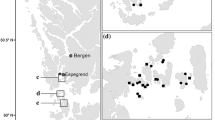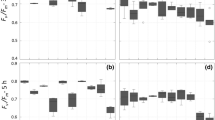Abstract
The invasive marine green macroalga Codium fragile ssp. tomentosoides is now considered to be an introduced marine pest along the northwest Atlantic and southern Australian coasts. International or domestic translocation of C. fragile ssp. tomentosoides is usually attributed to the fouling of ship hulls or shellfish, particularly oysters. A likely domestic vector is shipboard transport, involving the translocation of whole thalli or fragments entangled in fishing nets, ropes, etc. that are then released in a previously unaffected area. Here we investigated the survival of C. fragile ssp. tomentosoides under emersed conditions, simulating shipboard transport. C. fragile ssp. tomentosoides was able to survive periods of emersion of up to 90 days in high relative air humidity. Net photosynthesis remained positive at about 50% of the rates of submersed control thalli. After 2 days of emersion and 4 days of rehydration under submersed conditions thalli recover to their initial net photosynthesis rates. Hence, C. fragile ssp. tomentosoides is likely to survive long shipboard journeys entrapped in fishing nets, anchor wells or other protected, high-humidity areas of a vessel. Furthermore, C. fragile ssp. tomentosoides may survive emersion on an exposed deck during short trips, especially in cooler conditions such as at night. The incursion sites of C. fragile ssp. tomentosoides in Australia are generally in modified environments, often associated with shipping-related infrastructure such as wharves, jetties, rip rap, and moorings.
Similar content being viewed by others
References
CA Borden JR Stein (1969) ArticleTitleReproduction and early development in Codium fragile (Suringar) Hariot: Chlorophyceae Phycologia 8 91–99
CF Boudouresque M Verlaque (2002) ArticleTitleBiological pollution in the Mediterranean Sea: invasive versus introduced macrophytes Marine Pollution Bulletin 44 32–38 Occurrence Handle11883681 Occurrence Handle10.1016/S0025-326X(01)00150-3 Occurrence Handle1:CAS:528:DC%2BD38XmsVyruw%3D%3D
SJ Campbell (1999) ArticleTitleOccurrence of Codium fragile supsp. tomentosoides (Chlorophyta, Bryopsidales) in marine embayments of southeastern Australia Journal of Phycology 35 938–940 Occurrence Handle10.1046/j.1529-8817.1999.3550938.x
JT Carlton JA Scanlon (1985) ArticleTitleProgression and dispersal of an introduced alga: Codium fragile ssp. tomentosoides (Chlorophyta) on the Atlantic coast of North America Botanica Marina 28 155–165
JC Carpenter (1990) ArticleTitleCompetition among marine macroalgae: a physiological perspective Journal of Phycology 26 6–12 Occurrence Handle10.1111/j.0022-3646.1990.00006.x
G Ceccherelli F Cinelli (1999) ArticleTitleThe role of vegetative fragmentation in dispersal of the invasive alga Caulerpa taxifolia in the Mediterranean Marine Ecology Progress Series 182 299–303 Occurrence Handle10.3354/meps182299
AS Chapman (1999) ArticleTitleFrom introduced species to invader: what determines variation in the success of Codium fragile ssp. tomentosoides (Chlorophyta) in the North Atlantic Ocean? Helgoländer Meeresunters 52 277–289 Occurrence Handle10.1007/BF02908902
Cranfield HJ, Gordon DP, Willan RC, Marshall BA, Battershill CN, Francis MP, Nelson WA, Glasby CJ and Read GB (1998) Adventive marine species in New Zealand. NIWA Technical Report # 34, Wellington, New Zealand, 48 pp
EA Drew (1983) ArticleTitlePhysiology of Laminaria 1 Use of excised lamina discs in short and long term experiments P.S.Z.N. I: Marine Ecology 4 211–226 Occurrence Handle1:CAS:528:DyaL2cXjt1egsQ%3D%3D
FI Dromgoole (1975) ArticleTitleOccurrence of Codium fragile subspecies tomentosoides in New Zealand waters New Zealand Journal of Freshwater Marine Research 9 257–264 Occurrence Handle10.1080/00288330.1975.9515564
FI Dromgoole (1980) ArticleTitleDesiccation resistance of intertidal and subtidal algae Botanica Marina 23 149–159 Occurrence Handle10.1515/botm.1980.23.3.149
FI Dromgoole (1982) ArticleTitleThe buoyant properties of Codium Botanica Marina 15 391–397
RL Fletcher G Blunden BE Smith DJ Rogers BC Fish (1989) ArticleTitleOccurrence of a fouling, juvenile, stage of Codium fragile ssp. tomentosoides (Goor) Silva (Chlorophyceae, Codiales) Journal of Applied Phycology 1 227–237 Occurrence Handle10.1007/BF00003648
CL Hewitt ML Campbell F McEnnulty KM Moore NB Murfet B Robertson B Schaffelke (2005) ArticleTitleEfficacy of physical removal of a marine pest: the introduced kelp Undaria pinnatifida in a Tasmanian Marine Reserve Biological Invasions 7 251–263 Occurrence Handle10.1007/s10530-004-0739-y
E Leppäkoski S. Gollasch S. Olenin (Eds) (2002) Invasive Aquatic Species of Europe – Distribution, Impact and Management Kluwer Academic Publishers Dordrecht, The Netherlands 583
JA. Lewis (1999) A review of the occurrence of exotic macroalgae in Southern Australia, with emphasis on Port Phillip Bay, Victoria CL Hewitt ML Campbell RE. Tresher RB. Martin (Eds) Marine Biological Invasions of Port Phillip Bay, Victoria. Centre for Research on Introduced Marine Pests. Technical Report No. 20 CSIRO Marine Research Hobart, Australia 61–87
J Lubchenco (1980) ArticleTitleAlgal zonation in the New England rocky intertidal community: an experimental analysis Ecology 61 333–344 Occurrence Handle10.2307/1935192
JW Markham E Hagmeier (1982) ArticleTitleObservations on the effects of germanium dioxide on the growth of macroalgae and diatoms Phycologia 21 125–130 Occurrence Handle1:CAS:528:DyaL38Xks1Onuro%3D
F McEnnulty NJ Bax B. Schaffelke ML. Campbell (2001) A review of rapid response options for the control of ABWMAC listed introduced species and related taxa in Australian waters Centre for Research on Introduced Marine Pests. Technical Report No. 23 CSIRO Marine Research Hobart, Australia 22–29
A Occhipinti-Ambrogi D Savini (2003) ArticleTitleBiological invasions as a component of global change in stressed marine ecosystems Marine Pollution Bulletin 46 542–551 Occurrence Handle12735951 Occurrence Handle10.1016/S0025-326X(02)00363-6 Occurrence Handle1:CAS:528:DC%2BD3sXjsVaqtL4%3D
EJ Paula VR Eston (1987) ArticleTitleAre there other Sargassum species potentially as invasive as S. muticum? Botanica Marina 30 405–410
J Ramus (1972) ArticleTitleDifferentiation of the green alga Codium fragile American Journal of Botany 59 478–482 Occurrence Handle10.2307/2441529
G Relini M Relini G Torchia (2000) ArticleTitleThe role of fishing gear in the spreading of allochthonous species: the case of Caulerpa taxifolia in the Ligurian Sea ICES Journal of Marine Science 57 1421–1427 Occurrence Handle10.1006/jmsc.2000.0913
MA. Ribera C-F. Boudouresque (1995) Introduced marine plants, with special reference to macroalgae: mechanisms and impact FE. Round DJ. Chapman (Eds) Progress in Phycological Research, Vol. 11 Biopress Bristol, UK 187–268
A Ricciardi R Serroya FG Whoriskey (1995) ArticleTitleAerial exposure tolerance of zebra and quagga mussels (Bivalvia: Dreissenidae): implications for overland dispersal Canadian Journal of Fisheries and Aquatic Sciences 52 470–477
N Sant O Delgado C Rodriguez-Prieto E Ballesteros (1996) ArticleTitleThe spreading of the introduced seaweed Caulerpa taxifolia (Vahl) C Agardh in the Mediterranean Sea: testing the boat transportation hypothesis Botanica Marina 39 427–430 Occurrence Handle10.1515/botm.1996.39.1-6.427
PC Silva HBS Womersley (1956) ArticleTitleThe genus Codium (Chlorophyta) in southern Australia Australian Journal of Botany 4 261–289 Occurrence Handle10.1071/BT9560261
C. Sliwa (1999) An alternative dispersal mechanism for the introduced Japanese macroalga Undaria pinnatifida Honours Thesis University of Tasmania Australia 37
CM Smith LJ Walters (1999) ArticleTitleFragmentation as a strategy for Caulerpa species: fates of fragments and implications for management of an invasive weed PSZN: Marine Ecology 20 307–319 Occurrence Handle10.1046/j.1439-0485.1999.2034079.x
RC Starr JA Zeikus (1993) ArticleTitleUTEX – the culture collection of algae at the University of Texas in Austin Journal of Phycology 29 IssueIDSuppl. 1–106 Occurrence Handle10.1111/j.0022-3646.1993.00001.x
CD Trowbridge (1998) ArticleTitleEcology of the green macroalga Codium fragile (Suringar) Hariot 1889: invasive and non-invasive subspecies Oceanography and Marine Biology – An Annual Review 36 1–64
CD Trowbridge (1999) An assessment of the potential spread␣and options for control of the introduced green macroalga Codium fragile ssp. tomentosoides on Australian shores Report to the Department of Natural␣Resources and the Environment Hobart Australia 43
ER Wassman J Ramus (1973) ArticleTitlePrimary-production measurements for the green seaweed Codium fragile in Long Island Sound Marine Biology 21 289–297 Occurrence Handle10.1007/BF00381085
HBS. Womersley (1981) Marine ecology and zonation of temperate coasts M.N. Clayton RJ. King (Eds) Marine Botany: An Australasian Perspective Longman Cheshire Melbourne 211–240
Womersley HBS (1984) The marine benthic flora of Southern Australia. Part 1, DJ Woolman, Government Printer, South Australia, pp 224–240
Author information
Authors and Affiliations
Corresponding author
Rights and permissions
About this article
Cite this article
Schaffelke, B., Deane, D. Desiccation tolerance of the introduced marine green alga Codium fragile ssp. tomentosoides – clues for likely transport vectors?. Biol Invasions 7, 577–587 (2005). https://doi.org/10.1007/s10530-004-5850-6
Received:
Accepted:
Issue Date:
DOI: https://doi.org/10.1007/s10530-004-5850-6




